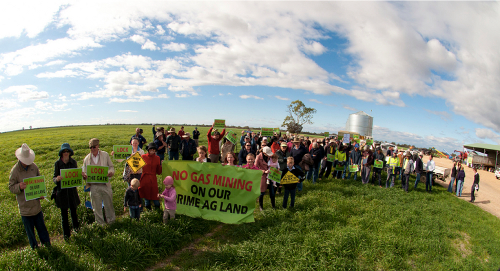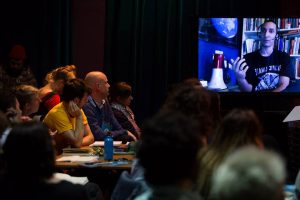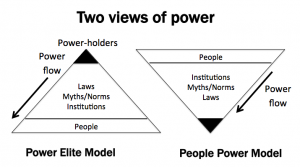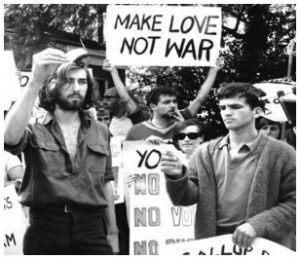Holly Hammond and Sam La Rocca presented a workshop at Progress 2015, along with a video presentation from Daniel Hunter. The workshop explored Daniel’s metaphor ‘politicians are like a balloon tied to a rock’. This article from Holly and Sam captures the ideas shared in the workshop as a contribution to further discussion amongst campaigners and change agents.
Plan to Win’s bookclub on US activist educator Daniel Hunter’s Strategy and Soul got us thinking about the relationship between community, politicians and sustained social change. Strategy and Soul is the riveting David versus Goliath story of the campaign against Philadelphia casino development. The book reads like a novel but teaches like a strategy manual.
One of the most compelling concepts discussed in the bookclub was ‘moving the rock’. Daniel writes:
“Politicians are like a balloon tied to a rock. If we swat at them, they may sway to the left or the right. But, tied down, they can only go so far. Instead of batting at them, we should move the rock: people’s activated social values. When we move the rock, it automatically pulls all the politicians towards us — without having to pressure each one separately.” (p.184)
Watch Daniel Hunter explain the metaphor and how he came up with it during the Philadelphia anti-casino campaign.
At one point in the video Daniel struggles to find a word to describe another metaphor, we’re guessing he meant ‘weathervane’. Rebecca Solnit has used this metaphor for talking about the relationship between social movements and politicians in her article ‘One magical politician won’t solve climate change: It’s up to all of us‘.
We believe Daniel’s rock and balloon metaphor generates valuable insights to inform campaigns, which aim to move political and corporate targets. The metaphor requires us to reflect on our understandings of power.
US strategist Bill Moyer’s Movement Action Plan (MAP) is referenced in Strategy and Soul. Moyer offers two models for understanding power that can help us make sense of the metaphor.
The Elite Power Model sees power sitting at the top with so-called ‘powerholders’ who decide the rule of laws, norms and institutions in society. Power is seen as flowing down and over people. If we see power like this it makes sense to focus on the balloon. This is the traditional story of power in society that many of us have had reinforced repeatedly in our upbringings, education, exposure to the media, and in some of the theories of change we’ve come across in social movements. If we take on board the assumption that those at the top hold all the power then it makes sense to focus our social change efforts on influencing ‘powerholders’, to ‘swat the balloon’ as Daniel puts it.
The People Power Model sees power in the hands of the people. People provide support for laws, norms and institutions, which enables political and corporate decision makers to undertake certain actions. The People Power Model is aspirational as it reflects a deeper participatory democracy that would reflect the will of the people – it is what multiple movements are working towards. It is also descriptive of the status quo, which involves the consent of the people to be governed, with progressive social change occurring through the engagement of people in social movements (see Gene Sharp’s Consent Theory of Power). If we see power in this way it makes sense to focus social change efforts on the rock.
Daniel describes the rock as people’s activated social values. People’s activated social values define the bounds of what is perceived as acceptable in laws, cultural norms, societal institutions, government and corporate decision-making. Politicians in particular are attuned to where people are at on any given issue so they know what will be accepted or not by the community (the electoral weathervane).
What does it mean to activate people’s social values and how do we go about doing it?
It makes sense to start with values, and frame our campaigns around the violation of widely held values. Beneath every social and environmental injustice there is a violation of community values and it’s the role of campaigns to highlight that and engage people. Many of us already know how important this is but we often struggle to put it into practice. We get absorbed in the detail of the problem and potential solutions and communicate that drily to potential supporters, or we just keep stating the problem as if the values are self-evident, and when everyone gets it things will miraculously change.
George Lakoff has been challenging progressives for many years to communicate values, not policy detail, and with each passing year he seems to get more frustrated! Tools like the Common Cause values deck of cards may be useful to spark deeper conversations about values during campaign development.
To activate social values we must put the problem clearly on the agenda. A review of social movement history reveals the important role of rebels in this. When Bill Moyer names four archetypal activist roles (Citizens; Reformers; Rebels; and Change Agents) he describes the attributes of effective Rebels:
- They protest: saying NO! to violations of positive values
- They use nonviolent direct action and civil disobedience
- They put problems in the public spotlight
- They are strategic and use creative tactics
- They are exciting, courageous, and risky
Rebel actions communicate our values in action not just words, they bring our values to life, and give people a tangible way to express what they believe and feel. Effective rebels help an issue cut through, challenge passivity and dramatise the dynamics at play. Powerful actions show rather than tell political, corporate and community decision makers where the people are at. Polls might give us breadth, but action gives us depth.
It follows that to activate social values we need to provide powerful actions for people to take. A petition can be a great early low-barrier tactic that builds a base to work from, but it doesn’t tend to reflect the deeply held concerns people hold. Likewise, rallies where people are expected to just turn up and stand around miss an opportunity to really activate people and communicate their values. Daniel Hunter talks about actions which align body, mind and soul and says:
“The question is – do people have a hook where they can see how to activate their value? Do they have something that they get to do that allows them to give expression to it, and not only expression but actually to make it happen in some way.”
Burning a draft card, going and shutting a bank account and chopping up a bank card are not just symbolic but real actions. Strategy and Soul describes a ballot initiative taken by the campaign, which was a real election, complying with rigorous electoral standards, not a street theatre caricature.
Generally, social values aren’t activated overnight; it takes time, energy and momentum to shift the rock. Community organising is a valuable approach as it focuses on growing the numbers of people engaged, deepening commitment, developing leaders, and building the ongoing infrastructure which allows people to act collectively. For further information read Plan to Win’s ‘Community Organising Basics‘.
This need for long term and ongoing activation is something that activists working on climate related issues have been learning about in recent years.
 In campaigning for action to respond to global warming, we’ve constantly been told we need to campaign for what’s politically realistic, which is often a lot less than what the science demands. The Movement Generation Justice and Ecology Project came up with this Circles of Strategy diagram to articulate the challenge.
In campaigning for action to respond to global warming, we’ve constantly been told we need to campaign for what’s politically realistic, which is often a lot less than what the science demands. The Movement Generation Justice and Ecology Project came up with this Circles of Strategy diagram to articulate the challenge.
We know we need radical and ambitious solutions to respond to the real and immediate threats of global warming but we are often accepting solutions that are considered more politically palatable than absolutely effective while at the same time fighting false solutions driven by our opponents to avoid making the necessary changes. While getting what you can with the power you’ve got is important, we believe the only real way of dealing with this challenge is to build our power to expand what is considered politically realistic.
The rock is one way of marking out what is considered politically realistic. This is the political space the community creates or shuts down by activating people’s social values in ways that clearly articulate what is or isn’t acceptable to political, corporate or community targets. Defining this political space is a dynamic contest of power between groups of people and institutions pushing in sometimes competing directions.
In 2010, one way people’s social values were activated around the climate debate was to shift their vote away from the old parties they felt weren’t taking global warming seriously to the Greens who campaigned for a price on pollution and investment in renewable energy. The Greens won balance of power in both houses of federal parliament putting them in a position, with a couple of country independents, to support a Labor minority government with a few conditions – including pricing carbon pollution.
While parliamentarians and their advisers worked hard to reach agreement on the Clean Energy Futures package, it looked like the movement who supported that policy direction stopped consistently and effectively activating people’s social values around action on climate change. Of course people did some good work during that time, we just didn’t push hard enough to keep the rock where we needed it and to keep the political space open in our favour.
Tony Abbott and his friends in big and dirty business took the opportunity to successfully push the rock into a new frame, activating people’s values around the cost of living and trust in the Gillard Labor government’s legitimacy.
 In Melbourne the Greens kept campaigning. Over the three years of Adam Bandt’s first term people’s values around safety, innovation, and clean economy were activated so much so that they were willing to take action they’d not really taken before like knock on the doors of their neighbours, call complete strangers, and talk to them about climate change, clean power and voting for someone to champion action in parliament. This concerted campaigning meant that the electorate of Melbourne maintained progressive representation while most of the rest of the country swung to the right.
In Melbourne the Greens kept campaigning. Over the three years of Adam Bandt’s first term people’s values around safety, innovation, and clean economy were activated so much so that they were willing to take action they’d not really taken before like knock on the doors of their neighbours, call complete strangers, and talk to them about climate change, clean power and voting for someone to champion action in parliament. This concerted campaigning meant that the electorate of Melbourne maintained progressive representation while most of the rest of the country swung to the right.
Having committed political representatives helps shift political space but the reality is even parliamentarians on side with our issues are still tied to the rock. They can only get done what the political space allows. They can help but it’s our job to move the rock.
One campaign that has moved the rock in recent years is communities against unsafe coal and gas mining. The Lock the Gate Alliance and community networks have activated people’s values about protecting agricultural land, keeping our water safe and communities healthy in ways that have moved the rock — and shut down the space for unabated, unsafe CSG, coal and unconventional gas mining (for politicians and corporations).
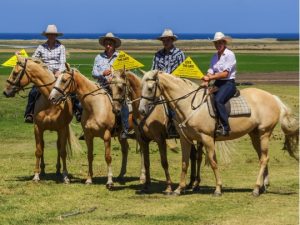 People have not just shut their gates; they’ve locked them. They’ve engaged neighbouring farms to do so too, they’ve filled community halls to watch films about fracking, doorknocked entire towns with surveys and declared them gasfield free, they’ve taken to cleaning up the political system with creative action groups like the Sadies, and challenging politicians with Knitting Nannas‘ regular office sit ins, and many more unexpected characters from farmers to medical doctors and people of faith have all put their bodies on the line, risking arrest to protect land, water and community health.
People have not just shut their gates; they’ve locked them. They’ve engaged neighbouring farms to do so too, they’ve filled community halls to watch films about fracking, doorknocked entire towns with surveys and declared them gasfield free, they’ve taken to cleaning up the political system with creative action groups like the Sadies, and challenging politicians with Knitting Nannas‘ regular office sit ins, and many more unexpected characters from farmers to medical doctors and people of faith have all put their bodies on the line, risking arrest to protect land, water and community health.
As a result, we saw during the NSW election in 2015 that politicians of all stripes felt compelled to, or appear to, do something about CSG. And when their positions weren’t good enough, people shifted their votes too.
By focusing on the rock rather than the balloon we can ensure whomever is elected has the political space to take ambitious action on the things we care about. It’s political parties’ job to get them elected. It’s our job to tell them on what terms.
Moving the rock may also result in a range of social and cultural changes beyond political positioning and law reform, such as communities finding their own solutions and building alternative institutions or communities demanding corporations clean up their acts. The short cut of ‘swatting the balloon’, even though it may sometimes result in short term gains, misses the deeper and potentially longer lasting change that comes from activating social values.
What do you think? What’s your experience of working on the rock or balloons? How have campaigns you’ve seen activated social values effectively and won?
See Moving the Rock: Shifting Power for Sustained Change for more words from Daniel Hunter and responses from other campaigners, and the Strategy and Soul site for excerpts from the book and sales.

